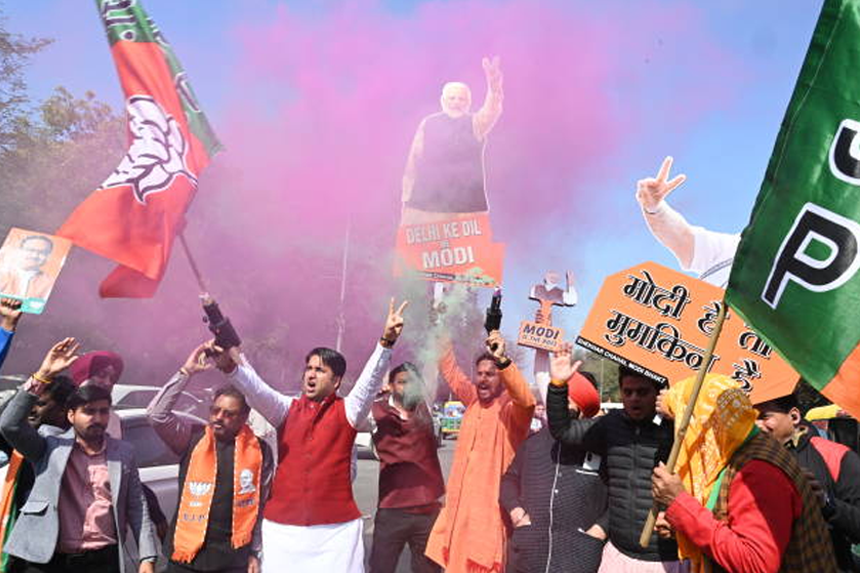An important turning point in Indian politics has been reached with the victory of Prime Minister Narendra Modi’s Bharatiya Janata Party (BJP) in the Delhi Election. Having won or led in 48 of the 70 seats in the legislative assembly, the BJP is poised to form the capital’s government after 27 years. The ruling Aam Aadmi Party (AAP), on the other hand, was in the lead in just 22 seats. With this significant lead, the BJP is ready to take power. Thirty-five seats is the halfway point needed to create a government.
- What Does the AAP and Its Leadership Stand to Gain from This Win?
- Why Was the BJP's Win in the Delhi Election So Important?
- Why Did the Congress Not Have an Effect on the Election in Delhi?
- What Was the Reason Behind the AAP's Request to Reduce in the Delhi Election?
- How Did the Delhi Election Voters Find the BJP's Campaign Appealing?
- Which AAP Setbacks Were the Biggest in the Delhi Election?
- What Impact Will the Outcome of This Delhi Election Have on the Political Climate in Delhi?
Modi tweeted on X, “Development wins, good governance triumphs,” expressing his confidence that his party would do “everything possible” to advance Delhi’s development.
What Does the AAP and Its Leadership Stand to Gain from This Win?
The loss was a severe blow to the AAP, which is led by former Delhi Chief Minister Arvind Kejriwal. “I humbly accept the verdict and congratulate the BJP on its win,” Kejriwal said in a video statement posted on X, acknowledging the people’s decision. I hope that they fulfill the aspirations of the electorate. Given Delhi’s symbolic importance as the nation’s capital, the election was a prestige contest for both parties.
The AAP, which has ruled Delhi since 2013, has a solid track record of implementing welfare programs that appealed to voters. Its reputation was damaged, nevertheless, by recent accusations of corruption against some of its leaders, including Kejriwal. Even while the party refuted these accusations, they nevertheless left a big hole that the BJP swiftly filled with its financial and political clout.
Why Was the BJP's Win in the Delhi Election So Important?
After almost three decades out of power, the BJP saw winning Delhi as more than just an election victory; it was a vital footing in the capital. Particularly after their defeat in the general election of 2024, this triumph in the Delhi election marks the most recent phase of the party’s nationwide comeback. Both Modi and Home Minister Amit Shah attended important events as part of the party’s significant campaign investment.
Voters responded favorably to the BJP’s “double-engine” campaign, which promised stability and improved governance with the same party in control of both the federal and state governments. In addition, the BJP’s “Parivartan” (change) rhetoric resonated, and its extensive electoral infrastructure and resources helped it win by a landslide.
Why Did the Congress Not Have an Effect on the Election in Delhi?
With no seats won, the Congress, the main opposition party in the country, was unable to make a big impression in the Delhi election. The party, which ruled Delhi from 1998 to 2013, has been steadily losing support since it was overthrown because to accusations of corruption. The rise of AAP as a formidable force has further sidelined Congress, which now battles to reclaim its footing in Delhi politics.
What Was the Reason Behind the AAP's Request to Reduce in the Delhi Election?
The AAP’s defeat is a serious setback for a party that was once a shining example of reform and development. The AAP was praised for its emphasis on enhancing the city’s healthcare and education systems, but recent developments have made it less popular, especially among middle-class voters. It’s unclear when the working class and lower classes abandoned Kejriwal, who was once seen as the leader of the anti-corruption campaign, but he had refocused his attention on the impoverished.
Ongoing corruption accusations, which led to the imprisonment of important party officials like Manish Sisodia, severely hurt the AAP’s election campaign. The campaign suffered severe harm, and the AAP was unable to bounce back, even after the party leaders’ denials and subsequent release on bail. With its extensive financial resources and political apparatus, the BJP took advantage of this vulnerability.
How Did the Delhi Election Voters Find the BJP's Campaign Appealing?
The BJP’s message of growth and transformation was a major component of its campaign. The party pledged to provide women with financial assistance, enhance healthcare, and improve public schools. The federal budget last week, which included tax breaks for the middle class—a crucial voting bloc in Delhi—also gave the BJP a boost. Many city voters found resonance in these promises, which contributed to the BJP’s triumph.
Notably, Delhi’s ongoing air pollution crisis was one topic that did not take center stage during the campaign. Even though the city’s serious air quality crisis was acknowledged by all parties, the topic was mostly ignored throughout the election. Despite their pledge to cut Delhi’s Air Quality Index (AQI) in half by 2030, the BJP did not make this a major talking topic during the contentious campaign weeks.
Which AAP Setbacks Were the Biggest in the Delhi Election?
Top leaders Arvind Kejriwal and Manish Sisodia lost in the New Delhi and Jangpura constituencies, respectively, which was one of the biggest upsets for the AAP during the election. Even though Kejriwal was a well-known person in the city, his loss represented the larger difficulty the AAP was having in retaining its support among voters. The party’s deteriorating fortunes were further indicated by incumbent Chief Minister Atishi’s tight victory in the Kalkaji constituency.
What Impact Will the Outcome of This Delhi Election Have on the Political Climate in Delhi?
The BJP has established a strong presence in Delhi with its historic win, ushering in a new age of Delhi politics. The outcome of the Delhi election is expected to have a significant impact on Delhi’s political climate, particularly as the BJP continues to deliver on its promises of stability, governance, and development. However, as the BJP’s triumph solidifies its position going into the next election cycle, the dispersed opposition faces a challenging road ahead.
Following this overwhelming win, the BJP has established a definite advantage in the capital, leaving the AAP to consider its future course and leadership. Delhi has a lengthy history of government, but the AAP’s inability to hold onto power suggests a significant change in the political landscape of the city.








